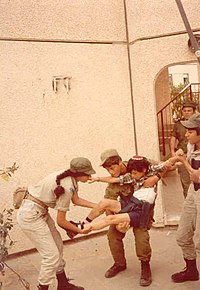Yamit
This article needs additional citations for verification. (August 2007) |
Yamit (Hebrew: ימית) was an Israeli settlement of 600 homes and approximately 2,500 inhabitants in the northeastern part of the Sinai Peninsula that was established during Israel's occupation of the peninsula from the end of the 1967 Six-Day War, until that part of the Sinai was handed over to Egypt in 1982 as part of the terms of the 1979 Israel-Egypt Peace Treaty. It was intended to have 200,000 residents, although it never grew past 3,000.
Located in the Rafah Plain region south of the Gaza Strip, Yamit was envisioned as a city, seaport, and the most populous Israeli community in the Sinai. Its location served to create an Israeli-populated buffer zone between the Gaza Strip and the Sinai peninsula. Despite efforts to promote Yamit's newly-built, relatively affordable housing, the settlement failed to attract enough residents to make it a seaport. Upon the signing of the peace treaty with Egypt, it became clear to residents that Yamit's days were numbered, and most accepted compensation and evacuated within two years. A minority of residents who chose to stay were joined by nationalist supporters, who moved in to boost their numbers.

Yamit was evacuated on April 23, 1982, amid resistance by some Yamit settlers, some of whom made a last stand on rooftops before being dragged into buses by Israeli soldiers. Among the more extreme examples of resistance were the disciples of Rabbi Meir Kahane, who vowed to take their own lives rather than surrender. It took personal intervention from the rabbi to prevent it.
The initial agreement between Israel and Egypt stipulated that Egypt would pay $80 million for the houses and infrastructure of Yamit. However, Israeli Prime Minister Menachem Begin (not Ariel Sharon as often thought) decided at the last minute to destroy the settlement instead. According to the Israeli ambassador to Egypt at the time, Moshe Sasson, Begin feared that the Israeli settlers would return to their homes surreptitiously and a disastrous clash between them and the Egyptians might occur. The decision to raze the settlement caused substantial ill will towards Israel among the Egyptian public.
In Israel, this precedent of Israelis forcibly evacuated from their homes by Israeli forces is considered a socio-political landmark, causing and/or signifying the widening rift in Israel between the religious nationalist Jews (such as NRP supporters) and the pragmatist, mainstream Israelis; it is one of the many fractures which the Israeli society has to deal with today, especially following the subsequent similar events of Israel's 2006 Realignment plan.
Since the demolition, the only structure that remains visible is a skeleton of the main synagogue, which contains no visible Jewish symbols. The bloodless evacuation of Israeli civilians and military from Yamit and the Sinai peninsula is considered as a precedent for Israel's policy of land-for-peace, exemplified in the Oslo Accords, the Gaza Disengagement, and the Realignment plan.
